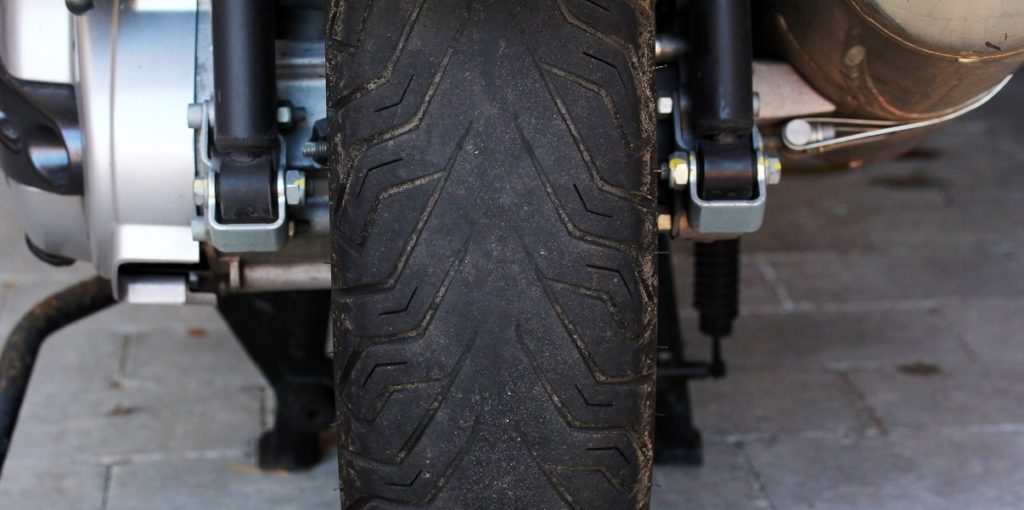Riding in the rain can be fun, provided you understand what to expect and how you can ride safely. There is always the possibility that you will encounter bad weather so it is important to be well-prepared for it.
Here are some essential tips to stay safe while riding your bike during a heavy downpour.
Before You Set-Off
The first set of tips focus on the things you must do before riding out in the rain.
Brakes
Brakes are crucial in wet conditions, you should ensure that your brake system is well maintained and working properly. Always test both brakes at low speed before opening the throttle up.
Read: Reasons why my motorcycle brakes won’t bleed
Also, make sure your ABS unit is regularly inspected and in good condition.
Tires

Check your tire pressure before you go on any ride, rain or shine. Tires need to be ready for water, which means they need tread. Inspect your tires for even wear and make sure their pressure is at the right level. Otherwise, they’ll perform unpredictably especially when wet, which is highly dangerous.
Read:
Leakages
Make sure to check your motorcycle for any leakages, including your brake fluid and oil. In dry conditions, an oil leak might not pose much of a safety risk. But when oil is mixed with water, it can create slippery and unsafe conditions for you during riding.
Choose The Right Gear
Wearing the right gear in wet weather and cold temperatures will help you stay safe and feel comfortable during the ride.
Here are some tips on choosing motorcycle gear for riding in the rain.
Rain Suits
Rain suits are specifically made to repel water. They can be worn over other riding gear and are extremely effective during heavy downpours. You can opt for one or two-piece suits, make sure you choose something breathable as they can cause overheating.
Reflective Vest And Accessories.
Always opt for gear that is visible in the dark. If you have all-black rain gear, consider getting a hi-vis vest and accessories that are reflective.
Gloves
A good pair of waterproof gloves are necessary to protect your hands, keep them dry, and maintain your grip.
Keep them on as much as possible even if they are wet, as they can quickly become cold if removed.
Have some towels on hand for drying since wet hands are difficult to slide into gloves. Also, tuck the gloves in the rain suit or the jacket tightly, so there is no space for water to enter.
Wear Layers
Having wet clothes and skin can make you feel cold, which slows your reaction times. So, make sure you stay warm and dry to help maintain your focus. Waterproof gear should add warmth to your outfit, but you may need more cover if the temperature is low. In this case, wearing layers is advisable.
Make sure to wear several thin ones rather than a single thick layer that’s difficult to remove. It is better to have more layers because you can remove them one at a time as needed.
Helmet
Having an anti-fog breath guard or a visor with a defrosting feature are some of your best bets when choosing helmets for rainy days. Wearing a full-face helmet will also provide the best protection as it covers your ears and eyes. Read more about how to stop a motorcycle helmet fogging up.
Moreover, pack a balaclava or snood to keep water and wind from directly getting to your face during a downpour.
For added protection, make sure it has straps that loop under your arms to prevent it from riding up and exposing a potential gap for water to seep in.
Clear Shield
It is pretty common to commute in the dark during winter nights. So, you might want to invest in a clear shield with higher visibility, like orange or yellow ones. An anti-fog face shield will also provide extra clarity.
Read more about riding a motorcycle at night.
Goggles
To avoid fogging your face shield, you can wear a dual-sport helmet. You may also want to switch to safety glasses instead of goggles as they don’t fog as easily.
Riding Techniques In The Rain
Riding in the rain will require certain tweaks to the way you handle and operate your motorcycle. This section goes through everything you need to know about these techniques.
Braking
In wet conditions, you’ll have to brake harder and slower so that your wheels don’t slip on the road. This means that you may need to use the rear brake more often with less of your weight going forward.
If you don’t have ABS, it’s a good idea to practice and get a feel for rear-wheel lockups. This will allow you to be more prepared in the event of a panic lockup.
Smooth throttle adjustments should be made in small increments with less lean angle. Remember to slowly apply your brakes, and apply them early so that you don’t feel the need to pull the brake lever hard.
Be Wary Of The Slick Roads

The first hour after a heavy downpour is especially hazardous as oils will rise to the surface of the road, along with accumulated oil and gas from passing vehicles. You should stop if you can. Wait for the storm to pass or wait until the rain has washed away all oil and other debris from the road before you get back on your bike.
This may be difficult to spot while riding, so remember to slow down when approaching intersections. Be aware that if you need to brake or turn quickly, you may encounter a traction issue. Also, avoid running yellow lights.
Look Out For Cars
Before stopping at a red light, check your rearview mirror for cars approaching from behind. Likewise, double your following distance in case vehicles suddenly stop in front of you.
Always plan ahead and keep a safe distance. You can’t count solely on having enough traction in the rain, as it will take a bit more time than usual for your bike to stop once you apply the brakes.
Keep An Eye Out For Traction Inhibitors
Manhole covers, painted lines, metal plates, pavement seals, and tar snakes can all make driving more treacherous in the rain because of reduced traction. Turning will also be harder, so make sure to do it slowly and focus more on traveling in a straight line. It’s also important to scan ahead of you when moving from one side to the other.
Check first to see if there are any lines that can be used to get around them. If there is none, you should not accelerate suddenly and avoid braking as much as possible so that you can roll over them without making any harsh inputs. Keep the throttle open and the bike upright if you are unable to avoid riding through a puddle.
Look For A Dry Path
Naturally, a dry road gives you better traction and control, so be sure to avoid areas that are waterlogged. When the opportunity allows, ride behind someone else’s track.
A car tire pushes the water away, allowing you to drive behind in its tracks. This way, you can move away from the wet part of the road and ride on a dry surface for a time.
Perform One Function At A Time
In normal conditions, it’s easy to perform several actions at once. But in the rain, it’s best to try not to combine any of these (i.e., brake before turning) to avoid the risk of fishtailing. Another tip is to stop accelerating before turning into a corner to prevent hydroplaning.
Adjust Your Position
Clinging too tight to the bike’s bars can cause fatigue, affect your balance, and prevent your suspension from functioning properly. Always maintain a proper riding position.
If you’re riding in a heavy spell of rain and your lap fills with water, stand up every now and then to keep water from accumulating. It can seep through fly zips if you don’t shake it off.
Avoid Riding During Lightning
If there’s lightning and rain, leave the road and find a safe place to wait it out. The lightning might only seek out tall objects, but it still poses a threat.
Final Thoughts
Every motorcyclist will face the rain at some point but it is nothing to be scared of. Some simple preparation such as bringing appropriate gear, maintaining your bike, and adapting your technique to the conditions will keep you safe.